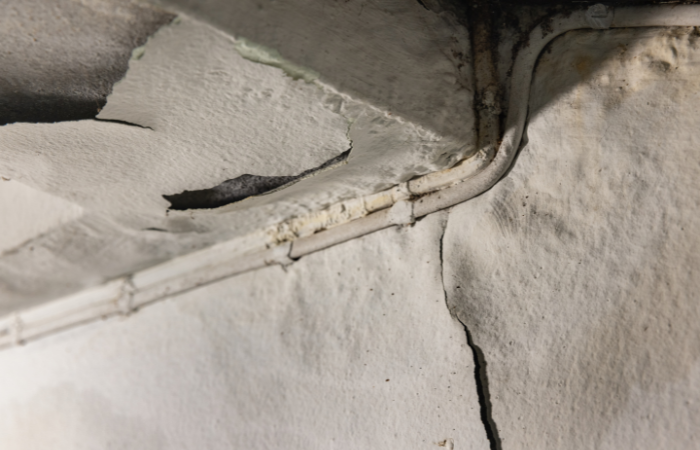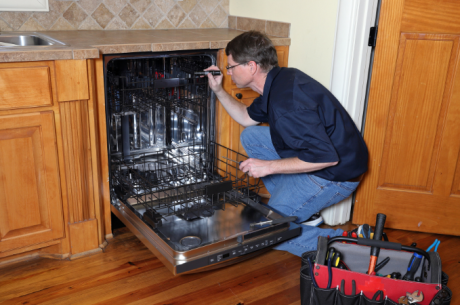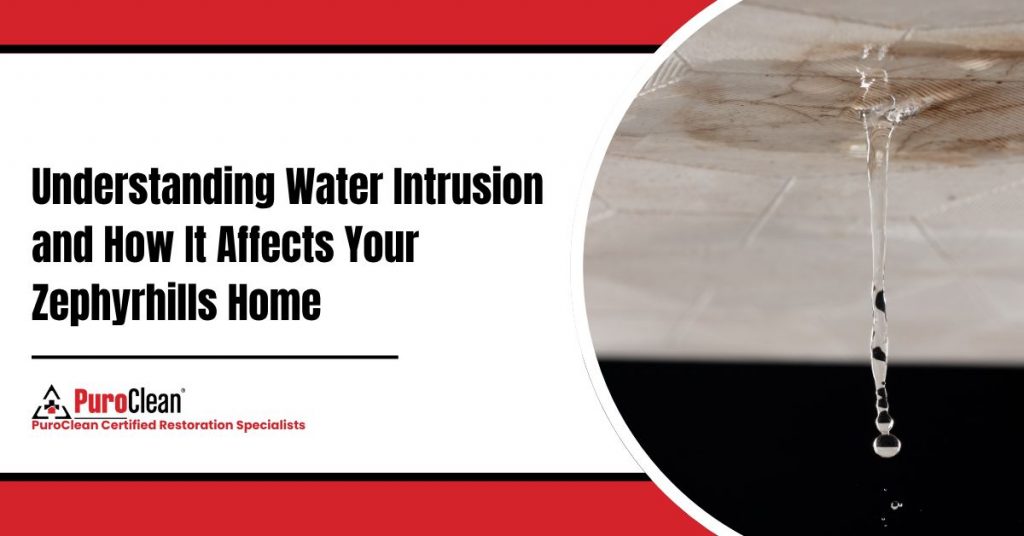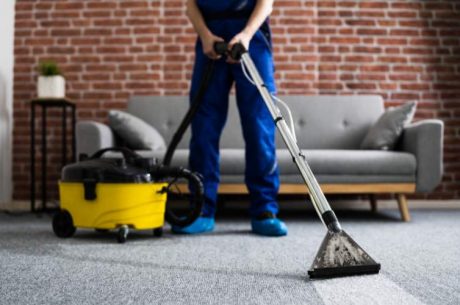In this article, we’ll discuss the key indicators that can help you identify if you have a slab or pinhole leak. By recognizing these signs of water damage early on, you can address the problem before it escalates into a major problem.
Imagine a leaking pipe hidden deep within your home’s foundation or walls, silently causing damage that you can’t see until it’s too late. Slab leaks and pinhole leaks are nightmares for homeowners, and they’re pretty common too. But the good news is they don’t have to be your nightmare.
1. Damp Patches on Walls or Ceilings
If you start noticing damp patches on your walls or ceilings, it could be a clear indication of a slab and pinhole leak. These damp patches occur when water seeps through tiny cracks in the slab or pipes and makes its way to the surface. The moisture then gets absorbed by the walls or ceiling, causing them to become damp.
If left untreated, these damp areas can lead to mold growth, which increases the health risks to you and your family. To address this issue, it is crucial to schedule a plumbing inspection as soon as possible. A water damage expert will be able to identify the source of the leak and provide necessary repairs before further damage occurs.
2. Decreased Water Pressure
One surefire way to recognize a potential problem is when your water pressure starts to decrease. If you notice that the water from your faucets and showerheads is coming out weaker than usual, it could be a sign of a leak. Decreased water pressure can occur when there is a blockage or break in the plumbing system, causing water to escape before reaching its intended destination. This can lead to inefficient water flow throughout your home.
To help you understand the warning signs of a slab and pinhole leak, here are five key indicators to look out for:
- Faucets taking longer to fill up: If you find yourself waiting longer than usual for your sink or bathtub to fill up, it could be due to reduced water pressure caused by a leak.
- Inconsistent flow from different fixtures: Uneven distribution of water between various faucets or showerheads may indicate an underlying plumbing issue.
- Water sputtering or spurting: When air gets trapped in the pipes due to leaks, it can cause irregular bursts of water from your taps.
- Prolonged time for appliances like dishwashers or washing machines: A decline in water pressure can affect the efficiency of these appliances as they rely on consistent and adequate supply.
- Difficulty flushing toilets: If you’re experiencing trouble flushing toilets despite using sufficient force on the handle, it could be another indication of low water pressure.
3. Unexplained Increased Water Bill
An easy way to spot a potential problem is when you notice your water bill suddenly getting higher than usual. If you haven’t changed your water usage habits, this increase could be a warning sign of a leak. These leaks can cause water to seep out from under your home’s foundation, leading to significant water loss and an increased water bill. To address this issue, it is important to take immediate action by identifying hidden leaks and practicing water conservation tips.
To identify hidden leaks, follow these steps:
– Start by checking all visible fixtures and pipes for signs of leakage.
– Inspect faucets, showerheads, toilets, and any exposed pipes for drips or puddles.
– Listen for the sound of running water when no fixtures are in use. This could indicate that there is a leak somewhere in your plumbing system.
– Monitor your water meter reading over a period of time when no water is being used in your home. If the meter reading increases despite no consumption, it suggests there might be a hidden leak.
Once you have identified a potential leak or confirmed its presence, it’s crucial to conserve as much water as possible until repairs can be made. One effective way to conserve water is by fixing any leaking faucets or toilets promptly. Even small drips can add up over time and significantly impact your overall usage. Another tip is to limit the length of showers and avoid leaving taps running unnecessarily while doing dishes or brushing teeth.
4. Random or Concentrated Water Stains
Random or concentrated water stains on your floors can be another telltale sign of a leak. These stains may appear as discolored spots or patches on your carpet, tile, or wooden flooring, indicating that water is seeping through from underneath. Such stains might seem puzzling at first, but they can be an indication of a hidden plumbing issue.
When you notice these water stains, it’s essential to take action promptly. Delaying repairs will likely lead to further damage to your flooring materials and, in worst-case scenarios, compromise the structural integrity of your home. Contacting a professional plumber to inspect the source of the leak and carry out necessary repairs can save you from costly flooring replacements and ensure your home remains safe and comfortable.
5. Foundation Shifts or Cracks
An alarming sign that a slab leak might be wreaking havoc on your property is the appearance of cracks or shifts in your home’s foundation. Slab leaks can lead to the soil beneath the foundation becoming saturated with water, causing the ground to expand and contract. Over time, this shifting of the soil can result in visible cracks in your foundation.
If you notice any new cracks in your walls, floors, or exterior foundation, it’s crucial to have a professional foundation inspection to determine the underlying cause. Ignoring these signs could lead to more extensive structural damage and expensive repairs. That’s why tackling the issue early on is important to help stabilize your home’s foundation and prevent further deterioration.
How to Prevent Slab and Pinhole Leak

Preventing these leaks is essential to protect your home from water damage and avoid costly repairs. While some leaks may occur due to unforeseen circumstances, there are proactive steps you can take to reduce the risk of these plumbing nightmares:
- Regular Plumbing Inspections: Schedule regular plumbing inspections by a licensed professional. A trained plumber can identify potential issues early on and address them before they escalate.
- Monitor Water Usage: Keep an eye on your water bills and monitor your water meter for any unexplained increases in usage. A sudden spike in water consumption may indicate a hidden leak.
- Address Leaks Promptly: Don’t ignore even minor leaks. Fix leaking faucets, showerheads, and toilets promptly to prevent further water wastage and damage.
- Insulate Pipes: Properly insulate exposed pipes to protect them from extreme temperatures and minimize the risk of a pinhole leak due to corrosion.
- Avoid Harsh Chemicals: Refrain from using harsh chemical drain cleaners as they can corrode pipes over time, potentially leading to leaks.
- Manage Water Pressure: Install a pressure regulator to maintain consistent water pressure within safe levels. High water pressure can strain your plumbing system and increase the risk of leaks.
- Foundation Maintenance: Keep an eye on your home’s foundation and address any cracks or shifts promptly. Maintain proper drainage around your home to avoid excess water accumulation near the foundation.
- Avoid DIY Plumbing Repairs: While it may be tempting to tackle plumbing issues yourself, it’s best to leave complex repairs to professional plumbers. DIY repairs can sometimes exacerbate the problem.
- Practice Water Conservation: Implement water-saving habits, such as shorter showers, fixing leaks promptly, and using water-efficient appliances. Conserving water not only reduces the risk of leaks but also helps the environment.
By following these preventive measures and staying vigilant for warning signs, you can safeguard your home from the detrimental effects of these leaks. Remember, early detection and timely action are your best allies in maintaining a dry, secure, and comfortable home.
Final Thoughts
Knowing the warning signs of slab and pinhole leaks can save you from potential headaches down the line. So, you have to remember that being proactive when it comes to maintaining your plumbing system will not only help preserve your property but also ensure efficient water usage and prevent unnecessary expenses.
If you suspect a slab and pinhole leak in your home, PuroClean Zephyrhills can help. We have a team of experts with years of experience addressing these types of leaks in residential properties. Contact us today!




 PuroClean Certified Restoration Specialists
PuroClean Certified Restoration Specialists